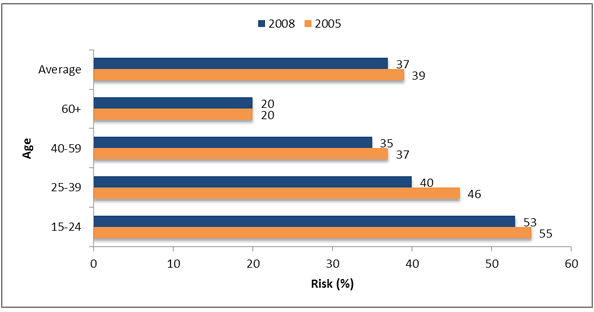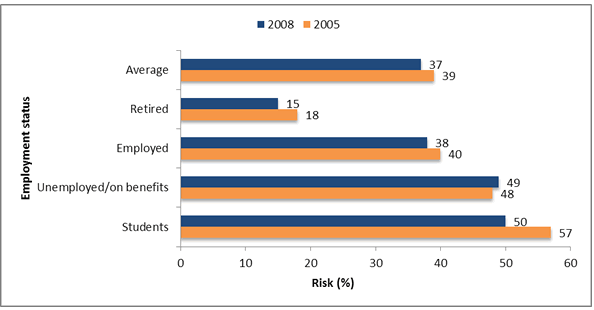Indicator 45: Neglect, abuse, and violence
| Indicator is fully reported? | Yes. | ||
| Type of indicator |  Outcome indicator Outcome indicator |
||
| Other relevant indicators |
Indicator for goal 5 of the New Zealand Positive Ageing Strategy – the proportion of people aged 60+ who:
|
||
| Our findings |
The Ministry of Social Development has published a report on its website using data from the most recent New Zealand Crime and Safety Survey. That report states that older people had a lower risk of victimisation (20%) than the national average for the 15+ population (37%) in 2008.[1] Sex and ethnicity data was not reported by age group because of the sample size. The Ministry of Justice’s website gives information about the crime and safety surveys and publishes the results online.[2] Data tables for the 2006 and 2009 surveys were not published, but will be for the next survey (which will run in 2014 and be reported on in 2015). A snapshot of results from the most recent survey is available at www.justice.govt.nz/publications/global-publications/c/NZCASS-2009/crime-and-safety-a-snapshot. The data shows that, in 2008, people aged 60+ were at less risk of victimisation than other age groups (see Figure 1). Retired people were at less risk of victimisation than people with another employment status (see Figure 2). More detailed data showed that people aged 60+ were less likely than other age groups to experience certain crimes: |
||
| Type of crime | National average | People aged 60+ | |
|---|---|---|---|
| Burglary | 14% | 8% | |
| Vehicle crime | 11% | 5% | |
| How entities use the data |
The New Zealand Police has used data from the surveys, along with its own intelligence information and information from other sources, to identify how changes to the population structure could affect policing and how police could respond. In summary, the Police have identified:
|
||
| Entities responsible for this indicator |
|
||
Figure 1: Relationship between age and the risk of victimisation, 2005 and 2008

Figure 2: Relationship between employment status and the risk of victimisation, 2005 and 2008

[1] www.msd.govt.nz/what-we-can-do/seniorcitizens/positive-ageing/progress/older-people-feel-safe-and-secure-and-can-age-in-the-community.html.
[2] www.justice.govt.nz/publications/crime/crime-and-safety-survey.
[3] Including older people with Alzheimers disease or dementia, who might wander away from where they were expected to be.
[4] Such as theft by people in a position of trust, (for example, a family member or care worker) or scams involving sending money out of the country.
[5] Elder abuse and neglect could occur in the older person’s home or an aged residential facility.
[6] The Police have also identified that traffic offences by older people could increase.

